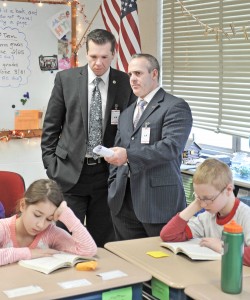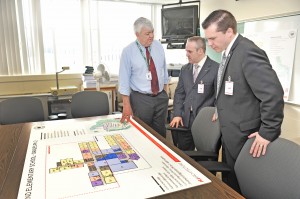
State Rep. Nicholas Boldyga, left, and Massachusetts Secretary of Education Matthew H. Malone, stand in the back of a sixth-grade classroom at Powder Mill Middle School as students concentrate on a reading assignment Friday morning. Malone toured the Southwick-Granville-Tolland Regional school district as part of an ongoing hands-on educational tour of the state. (Photo by Frederick Gore)
SOUTHWICK – State Secretary of Education Matthew H. Malone toured the Southwick-Tolland-Granville Regional schools Friday morning and was impressed with the unique campus renovations.
Before the tour, Malone met with Superintendent John D. Barry and State Rep. Nicholas Boldyga, and was later joined by State Sen. Donald F. Humason while touring Granville Village School.
Malone said he frequently visits schools across the state and has been to all but one county in the Commonwealth.
“I have been to schools everywhere but Nantucket, and I am scheduled to go there this spring,” said Malone. “I have visited 100 school districts in my first year as secretary.”
Malone said he was impressed with the renovations at the three schools on the Southwick campus and lauded the 7-12 combined middle and high school that is being built.
“The oldest and most successful high school in America is a 7-12 school – Boston Latin,” said Malone. “The new model we are seeing is this 7-12 school. What systems are getting rid of is middle school.”
Malone said it makes sense to move toward K-6 and 7-12 schools, and K-8 and 9-12 schools.
“Middle school is a great concept but it’s not providing the connections we want,” he said.
Malone said the transition to middle school, then again to high school, can be tough, especially for students with special needs who take comfort in the routines and familiarity of a school they attend for a longer time period.
“And, parents hate transitions, too,” Malone added.

Southwick Superintendent of Schools John D. Barry, left, explains an illustrated drawing of the newly redesigned Woodland Elementary School to Massachusetts Secretary of Education Matthew H. Malone, center, and State Rep. Nicholas Boldyga during a tour of the school district Friday. (Photo by Frederick Gore)
Barry said “districts our size are moving toward 7-12 schools.”
Southwick-Tolland-Granville Regional schools has 1,800 students in four buildings. The current middle school will become an intermediate school for grades 3-6 and the elementary school will offer classrooms for preschool through grade 2. Granville Village School will remain a K-8 school next year but could change to a K-6 school the following year.
Malone spoke about Gov. Deval Patrick’s budget and the emphasis on early education. He said there is a push to allow school systems the choice to open kindergarten to 4-year-olds.
“It’s not a mandate. Our goal with 4-year-olds is that systems that have the space could increase its early childhood education options and receive Chapter 70 funds,” Malone said.
Southwick does not receive Chapter 70 funds for kindergarten, but does receive kindergarten grants from the state. The district has free full-day kindergarten, which Malone said is another goal he hopes more schools will achieve.
Barry said kindergarten slots for 4-year-olds are of interest to parents.
“It’s a game changer,” Malone said.
Malone asked Barry about any issues the school department is currently facing. Barry said the renovation project is a challenge at times, but his concerns were about meeting deadlines for Race To the Top.
“It seems quick,” he said of the major changes RTT schools must make once accepted into the program. “There are a lot of us that think it would be better if we could take it slower.”
Malone said the state is under pressure from the federal government to meet deadlines, but as long as districts are progressing, he is happy.
“I don’t want people freaking out about (deadlines),” said Malone. “Just keep moving forward – slow progress is okay, we just don’t want people to stop.”
Malone spoke about the PARCC initiative and noted that the Board of Education did not adopt the program yet, but it did approve testing it.
The Partnership for Assessment of Readiness for College and Careers (PARCC) creates a standard set of K-12 assessments in math and English. Within PARCC, a group of states base the content of these assessments on what it takes to be successful in college and careers in the future. These examinations will also coincide with the full range of the Common Core State Standards Initiative to make certain that standards are present in classrooms.
Malone noted that while PARCC is being piloted now, Common Core was first introduced four years ago and most schools have already – or are getting ready to – implement it.
The PARCC was awarded Race to the Top assessment funds in September 2010 by the U.S. Department of Education to help in the development of the K-12 assessments. PARCC will include educators in the development of its assessments and will consult with more than 200 post-secondary systems to ensure that the examinations are preparing students for college and careers
Malone asked about the percentage of STGRHS graduates who go on to college, the number of students that go to vocational high schools, the METCO program, and more.

